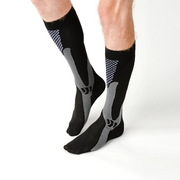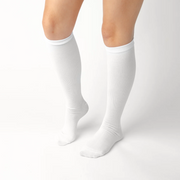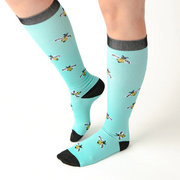Plantar Fasciitis and How Compression Socks Can Help (2025 VERSION)
Plantar fasciitis—an inflammation of the plantar fascia, the thick band of tissue supporting your foot’s arch—causes sharp heel pain and foot pain, especially during the first steps of the morning. For many, plantar fasciitis symptoms include heel pain, stiffness, and difficulty walking barefoot. Managing plantar fasciitis effectively involves supportive footwear, stretching exercises, and sometimes consulting a healthcare provider about treatments like shockwave therapy or custom orthotics.
Lately, compression socks for plantar fasciitis have gained popularity as a non-invasive way to relieve discomfort. Plantar fasciitis socks combine targeted arch support with varying compression levels, from mild to moderate. This graduated compression applies the highest pressure at the ankle and gradually lessens up the leg, improving blood flow to the plantar fascia. Better circulation helps reduce inflammation, reduce swelling, and accelerate pain relief.
Key Features of Plantar Fasciitis Socks
-
Arch Support & Heel Cushioning: Effective plantar fasciitis socks include built-in arch support and extra cushioning around the heel area. Some designs feature a Y-gore heel that conforms to the back of your foot and Achilles tendon, preventing bunching and ensuring a snug fit. This combination stabilizes the plantar fascia and absorbs shock, easing daily heel pain.
-
Optimal Compression Levels: Choices range from mild compression (15–20 mmHg) to moderate compression (20–30 mmHg). Mild compression can be sufficient for early or mild plantar fasciitis, while moderate compression suits recurring flare-ups or more intense foot pain. To find the right fit, measure calf circumference and reference sizing charts. A sock that fits properly delivers support without restricting blood flow.
-
Breathable, Moisture-Wicking Fabrics: Since plantar fasciitis often affects individuals on their feet for long periods, socks should have excellent sweat-wicking ability and breathable fabric. This helps keep feet dry, preventing fluid buildup that can worsen swelling and discomfort.
Practical Usage Tips
-
Wear During Peak Pain: Many find immediate relief by putting on plantar fasciitis socks first thing in the morning. The compression warms and stimulates the plantar fascia before stepping out of bed.
-
Combine with Stretching Exercises: Incorporate simple calf stretches and plantar fascia stretches to improve flexibility, reduce inflammation, and support sock effectiveness.
-
Use for Recovery & Prevention: If you spend prolonged standing intervals or walk for long periods, wear the socks during these activities. Afterward, continue wearing them to maintain blood flow, manage foot health, and alleviate lingering pain.
-
Rotate Compression Levels: If moderate compression feels too tight for evening wear, switch to a mild compression pair at night. Alternating between compression levels can prevent over-dependency on one pressure setting.
Complementary Strategies
While plantar fasciitis socks offer substantial support, pairing them with supportive footwear—shoes with built-in arch support and shock-absorbing midsoles—optimizes results. If pain persists, explore additional treatments such as custom orthotics, night splints, or shockwave therapy under guidance of a healthcare provider. Some anecdotal evidence suggests that combining plantar fasciitis socks with a night splint can further reduce morning heel pain.
Conclusion
For anyone coping with plantar fasciitis, compression socks provide a practical, drug-free approach to managing discomfort. By stabilizing the plantar fascia, improving blood flow, and cushioning the arch support and heel area, plantar fasciitis socks help relieve pain, reduce swelling, and support long-term foot health. When used alongside supportive footwear and stretching routines, these socks can be a critical tool in your strategy to alleviate plantar fasciitis symptoms and enjoy more comfortable, pain-free steps.
 Active Compression
Active Compression
 Plain Compression Socks
Plain Compression Socks
 Colourful Compression
Colourful Compression

